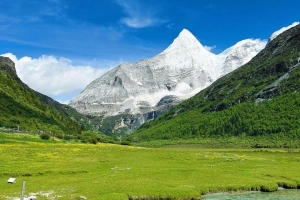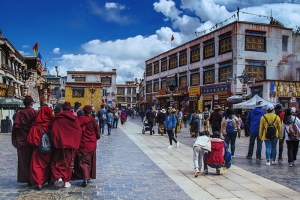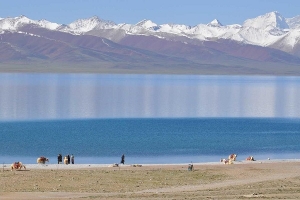Few images capture the spirit of Tibet like bright rows of fluttering prayer flags crowning mountain passes, temples, rooftops and riverbanks. To many visitors they are instantly photogenic – but beyond their colors and patterns lies a layered tradition of belief, prayer and poetic symbolism.
Tibetan Prayer Flags’ Origins And Early History
The prayer-flag tradition in Tibet predates Buddhism’s arrival on the plateau and is rooted in the indigenous Bon religion and ancient Himalayan shamanic practices. Early Bonpo rites used plain colored banners to invoke local spirits, protect mountain passes and mark sacred landscapes. Over centuries, Buddhist symbolism and Sanskrit mantras were printed onto the fabric, fusing older sky-and-spirit beliefs with the Dharma’s prayers and protective formulas. Today’s multicolored prayer flags – often called lungta or “wind horse” flags – carry this blended history in their images and texts, serving both as spiritual tools and as markers of Tibetan cultural identity.
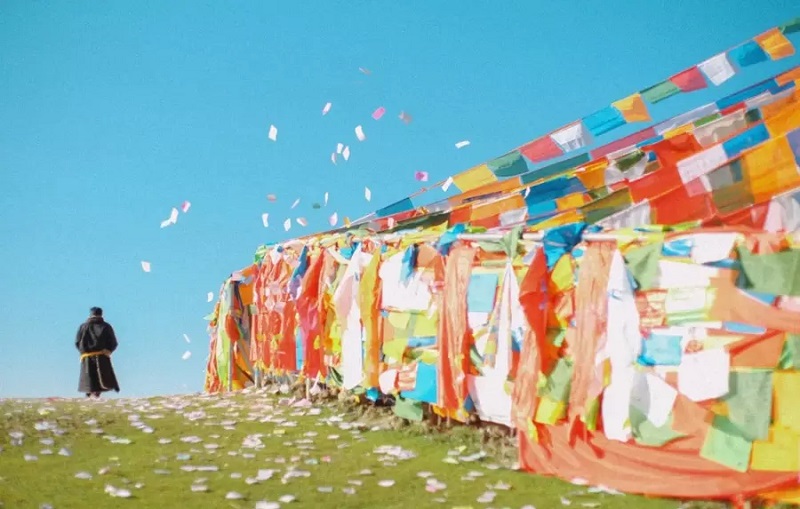
Tibetan Prayer Flags
What Is Printed On The Flags And Why It Matters
At first glance you may see small, repeated script and delicate block prints across each flag. Those are not decorative flourishes but sacred texts: mantras, dharani verses, auspicious symbols and stylized images like the wind horse, the “Three Jewels” (Buddha, Dharma, Sangha), and protective deities. In Tibetan belief the printed prayers are activated by the wind; as the fabric flutters, the mantras are released into the environment to bless all beings. Because of this function, flags are seen as instruments not of private petition but of public blessing—intended to benefit the land and everyone who shares it.
The Five Colors And Their Meanings
One of the clearest elements you’ll notice is the standard sequence of five colors: blue, white, red, green and yellow. These are never random—the order and palette are traditional and meaningful.
- Blue represents the sky or space.
- White stands for air and wind.
- Red symbolizes fire.
- Green denotes water.
- Yellow means earth.
Together the five colors encode a cosmology of balance: the five elements that sustain life, the five directions, and the five transcendental Buddhas and their associated wisdoms. When displayed in the prescribed sequence, the flags are thought to harmonize elemental forces and enhance wellbeing across the landscape. For travelers this color logic is more than folklore: it explains why you so often see a neat, repeating line of five hues on a pass or rooftop rather than a random scramble of colors.
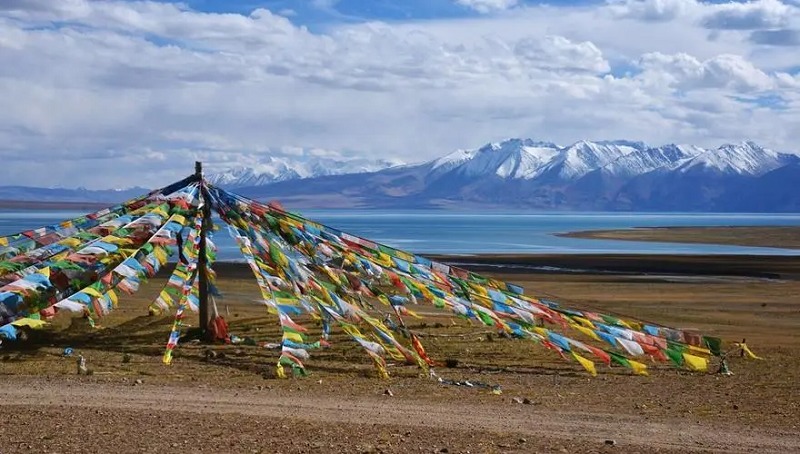
The five colors of the Buddhist prayer flags
Types And Forms Of Prayer Flags
Prayer flags appear in two broad forms and several local variants:
Lungta (Horizontal Flags)
These are the most familiar to visitors: rows of small, rectangular flags sewn along a string and draped between poles, trees, rooftops or along ridgelines. Lungta literally translates to “wind horse,” and many lungta flags prominently feature the wind horse motif—symbolic of speed, fortune and the transmission of blessings on the wind.
Darchog / Dar Cho (Vertical Flags)
Less common but equally striking, vertical flags are single large rectangles attached to a tall staff—often planted on hilltops, near temples or as part of ceremonial flagpoles. These vertical banners are sometimes called darchog, dar cho or dar chen, and they function more like a monumental marker or standard than the horizontal lungta strings.
Variations
You will also see long single-color strips used for ceremonial display, five-panel squares tied as cluster banners, and willow-branch prayer trees assembled during festival times. In urban settings such as Lhasa’s old town, prayer flags may be displayed in denser clusters—on balconies, across alleys and around the Jokhang Temple square—so their visual presence becomes part of daily life.
Symbolism: Wind, Horse, and Universal Blessing
Central to the flags’ symbolism is the notion that the wind is a carrier of blessing. The Tibetan term lung (wind) and ta (horse) combine to form lungta, the wind horse. This mythical horse is often shown galloping with three flaming jewels on its back—these jewels represent the Buddha, the Dharma, and the Sangha. The horse’s swiftness metaphorically spreads the prayers and transforms obstacles into good fortune.
Because the flags act on the winds, they are intended to bless the environment rather than to send requests to a deity in a personal, transactional way. In other words, the prayer flag ritual is ecological as much as it is devotional: the flags harmonize human intention with natural forces, seeking the wellbeing of all sentient beings rather than individual gain.
When And Why Flags Are Renewed
Tibetans commonly renew flags during important ritual times—most notably during Losar, the Tibetan New Year, when families and communities replace or refresh their rooftop and hilltop flags in a public ceremony. New flags may also be raised on auspicious dates chosen by local lamas, during major religious festivals like Saga Dawa (which celebrates the Buddha’s birth, enlightenment and parinirvana), or when families wish to commemorate births, marriages, recoveries from illness or other blessings.
Part of the spiritual logic holds that as flags fade and fray from sun and wind, their prayers have been fulfilled—fading is therefore an auspicious sign. For this reason Tibetans often keep old flags out of disrespectful places: they are either burned, ritually retired, or otherwise handled with reverence rather than tossed into the trash.

Fading prayer flags are considered auspicious
Where To See The Most Beautiful Displays
If you’re planning a trip, here are places where prayer flags are most abundant and most meaningful:
- Mountain passes and high ridges — passes between valleys are classical sites; the high winds carry prayers far.
- Monastery roofs and temple squares — major monastic centers drape flags across courtyards and stupas.
- River bridges and fords — bridgeheads are traditional places to anchor flags because they mark transitions and meeting points.
- Village rooftops and family homes — flags on roofs signal daily devotion and community protection.
- Pilgrimage routes and kora paths — circumambulation paths around sacred mountains and lakes are lined with offerings and fluttering cloth.
When you arrive, ask a local monk or guide to point out the most respectful vantage points—many temples place viewing spots for visitors that do not disturb ritual practices.
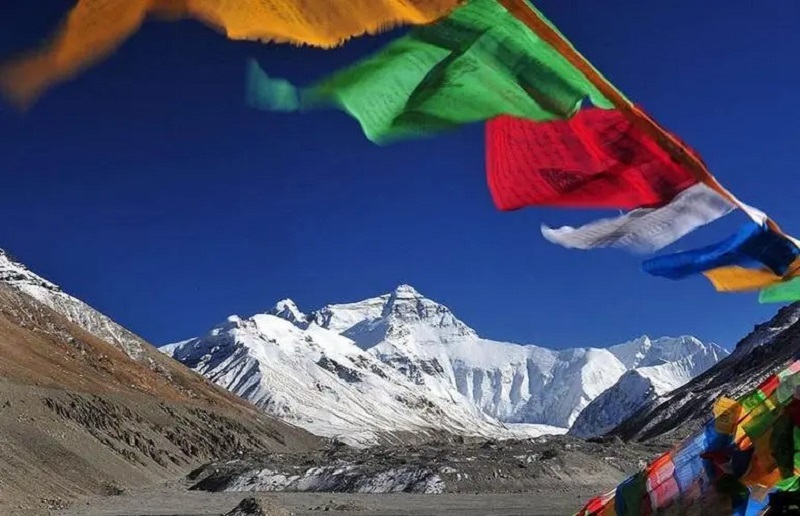
Fluttering prayer flags in front of Mt.Everest
Etiquette For Travelers: How To Show Respect
Prayer flags are sacred objects in Tibetan culture, so follow a few simple rules to behave respectfully:
- Don’t touch or grab a fluttering flag for a selfie. Ask a guide before handling any ritual object.
- Never let flags touch the ground—this is considered disrespectful. If you are helping to hang flags, make sure the cloth never drags.
- Avoid unintentional insults. Do not step over a flag line; if you must cross an area, find a path or ask permission.
- If you buy a flag abroad, treat it reverently. Many Tibetans prefer that prayer flags be gifted rather than purchased as casual souvenirs; if you bring flags home, use them with thoughtfulness rather than as throwaway decor.
- Photograph mindfully. Some rituals and practitioners should not be photographed. When in doubt, ask.
Following these simple steps helps preserve the meaning of the tradition and deepens the authenticity of your visit.
Gifts, Souvenirs And The Ethics Of Buying Flags
Tourists naturally want to bring home a piece of what they’ve seen. Buying a small prayer flag from a local craftsperson can support villages and monasteries—but be mindful:
- Prefer flags made locally by Tibetan artisans rather than mass-produced novelty items.
- Respect the intent: flags are not mere decorations. If you hang one at home, do so in a way that reflects reverence for the tradition—outdoors where wind can move them is preferable to indoor décor.
- Consider gifting: in Tibetan custom receiving a prayer flag from someone is an auspicious sign; giving a flag to a Tibetan friend or family is a meaningful gesture when appropriate.
If you’re unsure, ask your guide about local preferences and purchasing channels—ethical purchases often come with explanation of the flag’s symbolism and how the money supports the community.
The Poetic Meaning Of Fading And Renewal
Tibetans read the weathering of a flag as a kind of natural completion: the sun and wind erase ink and thread, and that wearing away shows that the blessing has been released. Unlike many cultures that discard faded objects as waste, Tibetan practice embraces the aging of prayer flags as a visible record of prayer. New flags are mounted alongside the old, creating layers of time and wish—an aerial palimpsest that makes the landscape both devotional and temporal.
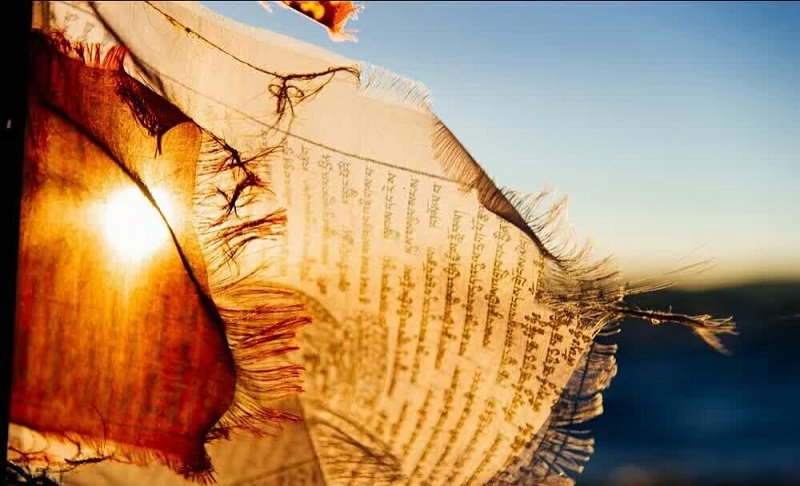
Prayer flags with sutras
Tibetan Prayer Flags’ Culture And Connection
Tibetan prayer flags are a visible language of faith, ecology and social memory. They stitch together the landscape and human hope, making theological ideas tangible on wind-bitten ridgelines and sunlit roofs. For international travelers, witnessing prayer flags in their home context is more than a photo op: it’s an invitation to slow down, learn a symbolic vocabulary and consider how cultures express care for both community and environment.
If you are organizing a trip to Tibet and would like a guided itinerary focused on cultural immersion—visiting monasteries, learning about lungta and flag rituals, attending a Losar flag-renewal ceremony—Journey2tibet can craft a respectful, permit-compliant program with experienced local guides who put cultural sensitivity first. They can also advise on where to buy authentic prayer flags, the right times to visit, and how to participate without disrupting local practice.
May the wind carry good wishes on your journey—and may the bright flags you see on Tibetan ridges carry their blessings into your travels and return.




